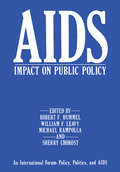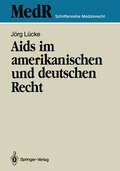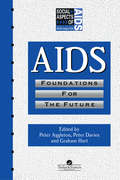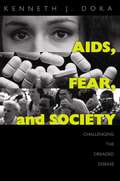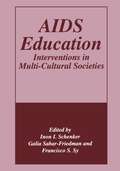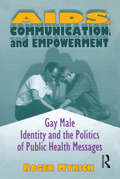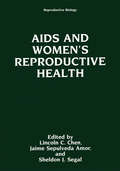- Table View
- List View
AIDS in Pakistan: Bureaucracy, Public Goods and NGOs
by Ayaz QureshiThis book is the first full-length study of HIV/AIDS work in relation to government and NGOs. In the early 2000s, Pakistan’s response to HIV/AIDS was scaled-up and declared an area of urgent intervention. This response was funded by international donors requiring prevention, care and support services to be contracted out to NGOs - a global policy considered particularly important in Pakistan where the high risk populations are criminalized by the state. Based on unparalleled ethnographic access to government bureaucracies and their dealings with NGOs, Qureshi examines how global policies were translated by local actors and how they responded to the evolving HIV/AIDS crisis. The book encourages readers to reconsider the orthodoxy of policies regarding public-private partnership by critiquing the resulting changes in the bureaucracy, civil society and public goods. It is a must-read for students, scholars and practitioners concerned with neoliberal agendas in global health and development.
AIDS in Asia (Developments In Cardiovascular Medicine Ser.)
by Yichen LuAsia has become the new battle ground for the war against HIV/AIDS. The magnitude of the potential public health problems caused by AIDS in this populous continent may become a catastrophic disaster. A 10% rate of prevalence of HIV-1 in India and China alone would mean more than 200 million people are infected with HIV. AIDS in Asia is useful as a comprehensive, up-to-date AIDS reference book for public health and medical professionals. This volume provides concrete information on the diagnosis, treatment, care, prevention and impact of AIDS. Part I contains 'Snapshots of HIV/AIDS in Asia.' Countries and regions included in this section are: Thailand, India, China, Japan, Vietnam, Laos, Cambodia, Myanmar, Malaysia, Indonesia, the Philippines, Pakistan, Nepal, Sri Lanka, Hawaii and the Pacific Islands, Hong Kong and Taiwan. Part II addresses the molecular epidemiology of HIV/AIDS. Part III deals with the diagnosis, surveillance and projected scenarios of the AIDS epidemic. Part IV outlines prevention efforts and treatment options. Part V provides an overview of the ongoing collaborative efforts involved in several different nations in the worldwide war against AIDS. This volume will be invaluable to all the public health professionals and researchers working in this field. "...the book is a useful addition to the HIV/AIDS literature." "AIDS in Asia offers a comprehensive, interesting overview of the epidemic there and of general issues that will influence its progression." -Roger Detels, MD, MS, University of California-Los Angeles The Journal of the American Medical Association, Book Review, 293:15
AIDS in America
by Charles H. RussellWhether one views it as an indictment of our lifestyle or merely as a The present volume is offered as a contribution to the information failure in the progress of science and medicine, the AIDS epidemic is campaign in the battle against the epidemic. It rests on the conviction undoubted I y one of the most agonizing experiences of our time. There that the increase of knowledge about AIDS will help to elevate the is hope for control of the disease--especially so in the development of power of public judgement, including a sense of moral restraint, to the an anti-AIDS vaccine-but the following stark facts are too over point necessary to bring about control and halt further spread of this powering for anyone to behold without sensing pain. Already close to terrible disease. The study as a whole, as well as the epidemic itself, 100,000 (or possibly more at this date) Americans have died of the raises questions about social ethics and about whether we may have disease, another 161,000 cases have been diagnosed, and estimates adopted a social philosophy which allows us to exceed appropriate place the additional number of infected persons at 1 million. 35,000 limits of independent personal behavior on the assumption that the new AIDS cases are reported annually in America, with a nearly equal consequences of our acts can always be managed by some sort of distribution among heterosexual and homosexual persons. technological fix.
AIDS in Africa: Responses To The Aids Treatment Crisis In Africa (A\line Drawn In The Sand (hup) Ser.)
by Max Essex Souleymane Mboup Phyllis J. Kanki Richard G. Marlink Sheila D. TlouThis comprehensive reference book addresses the unique challenges facing many African nations as poor infrastructure and economics continue to obstruct access to advanced treatments and AIDS care training. It takes into account the context of settings with limited resources. Information on how to best utilize existing resources and prioritize scaling-up of infrastructure is a critical aspect of this book for those working in HIV/AIDS-related fields in Africa.
AIDS Impact on Public Policy: An International Forum: Policy, Politics, and AIDS
by SherryChorost MichaelRampolla William F. Leavy Robert F. HummelAcquired Immune Deficiency Syndrome continues to be a major concern of the research and health care communities as well as the dominant public health issue in the news media. In the early years of the epidemic. attention was appropriately focused on characterizing the epidemiology of the disease in order to define the nature and extent of this new threat. However. as the disease affected the lives of ever increasing thousands of individuals and spread to almost every country. its ramifications were felt at every level of society. In addition to medical and research issues. profound social. economic and moral dilemmas have arisen. The implications which AIDS has on public policy continue to unfold. Recognizing the value of assembling those who were involved with AIDS on a national and international level. New York State through its Health Department brought together social scientists, researchers. clinicians. educators, community leaders. government officials and public policy analysts to explore and discuss major AIDS public policy issues at the AIDS International Symposium. This volume includes both the major papers presented as well as the discussions among the panel members which followed the presentations. Clearly, the conference demonstrated the international nature of AIDS as a public health and public policy problem. Evident also ;s that the devleopment of public policy properly begins as a dialogue, both at the interpersonal and international levels, and that the process is never complete, particularly when it concerns the type of threat that AIDS presents to the world community.
Aids im amerikanischen und deutschen Recht: Eine kritische Bestandsaufnahme des Rechts der USA und ihre rechtspolitischen Konsequenzen für die Bundesrepublik Deutschland (MedR Schriftenreihe Medizinrecht)
by Jörg LückeDas Buch stellt - unter Einbeziehung medizinischer Erkenntnisse - ausführlich die in den USA bestehende Rechtslage zur Immunschwächekrankheit Aids dar und vergleicht sie mit dem deutschen Rechtszustand. Behandelt werden - die Aids-Forschungsförderung (Art und Umfang der Förderung) - die Aids-Aufklärung (und zwar der Öffentlichkeit sowie einzelner Gruppen z.B. der Schüler, Lehrer, Ärzte, Gefangenen, Heiratswilligen) - die Pflicht zu HIV-Tests (von Blut- und anderen Spenden sowie von verschiedenen Personengruppen, z.B. der Immigranten, Heiratswilligen, Prostituierten, Gefangenen, Soldaten, Beamten, Krankenhauspatienten und der allgemeinen Bevölkerung) - der Schutz vor einer Diskriminierung HIV-Infizierter (insbesondere im Arbeitsleben, Schulwesen, Wohnungs- und Versicherungswesen). Die amerikanische Rechtslage wird in den einschlägigen Abschnitten jeweils einer umfassenden Bewertung unterzogen und darauf überprüft, ob sie für die Aids betreffende rechtspolitische Diskussion in der Bundesrepublik Deutschland fruchtbar gemacht werden kann.
The AIDS Health Crisis: Psychological and Social Interventions (Nato Science Series B:)
by Jeffrey A. Kelly Janet S. St. LawrenceAcquired immune deficiency syndrome (AIDS) poses a health threat unparalleled in modem times. Identified just a few years ago, AIDS and the human inunlmodeficiency virus (IDV) responsible for it affect millions of persons worldwide. AIDS has already become the leading cause of death among persons under 40 in some large American cities. From the beginning. it has been evident that AIDS carries unique psychological and social ramifications. In spite of its lethality, new cases of HIV infection are preventable if individuals can be assisted to make behavior changes to lessen or eliminate viral transmission. To the extent that we can develop effective primary prevention interventions, it will be possible to keep larger numbers of people from becoming infected with the mv virus. Psychological and social risk behavior change interventions, whether at the level of individual clients, groups, or entire communities, can playa key role-in fact, the only available role-in disease prevention. Patients with any life-threatening illness have psychological, social, and support needs. However, these needs are more pronounced and, often, less easily addressed for persons affected by AIDS. People in good clinical health but with HIV infection face years of worry concerning whether they will develop AIDS. Nearly 2 million Americans are currently in this precarious position; by 1991, 50 to 100 million persons worldwide are expected to share the same uncertainty.
AIDS: Foundations For The Future (Social Aspects of AIDS)
by Peter Aggleton Peter Davies Graham HartHIV and AIDS have posed new challenges to societies, communities and individuals. In many parts of the world, existing health and social services have been hard pressed to cope with the dermands of the epidemic. In hospitals and in the community, new approaches to health education, support and care have been developed. Non-governmental and community organizations have had a central role to play in responding to the challenge of HIV and AIDS. AIDS: Foundations for the Future highlights progress made over the last decade, and offers an agenda for future activism and research. This book examines the extent to which sound foundations for the future have been laid in public, private and voluntary sector action. It focuses on topics as diverse as workplace policy on HIV and AIDS, voluntary sector responses, the reactions of health care workers, the experience of living with AIDS, outreach work and community action, patterns of male prostitution, and new interventions to promote and maintain safer sex and safer drug use.
AIDS: Foundations For The Future (Social Aspects of AIDS)
by Peter Aggleton Peter Davies Graham HartHIV and AIDS have posed new challenges to societies, communities and individuals. In many parts of the world, existing health and social services have been hard pressed to cope with the dermands of the epidemic. In hospitals and in the community, new approaches to health education, support and care have been developed. Non-governmental and community organizations have had a central role to play in responding to the challenge of HIV and AIDS. AIDS: Foundations for the Future highlights progress made over the last decade, and offers an agenda for future activism and research. This book examines the extent to which sound foundations for the future have been laid in public, private and voluntary sector action. It focuses on topics as diverse as workplace policy on HIV and AIDS, voluntary sector responses, the reactions of health care workers, the experience of living with AIDS, outreach work and community action, patterns of male prostitution, and new interventions to promote and maintain safer sex and safer drug use.
AIDS, Fear and Society: Challenging the Dreaded Disease (Death Education, Aging and Health Care)
by Kenneth J. DokaFirst Published in 1997. Routledge is an imprint of Taylor & Francis, an informa company.
AIDS, Fear and Society: Challenging the Dreaded Disease (Death Education, Aging and Health Care)
by Kenneth J. DokaFirst Published in 1997. Routledge is an imprint of Taylor & Francis, an informa company.
AIDS Epidemiology: Methodological Issues
by Nicholas P. Jewell Klaus Dietz Vernon T. FarewellIn 1974, the Societal Institute of the Mathematical Sciences (SIMS) initiated a series of five-day Research Application Conferences (RAC's) at Alta, Utah, for the purpose of probing in depth societal fields in light of their receptivity to mathematical and statistical analysis. The first eleven conferences addressed ecosystems, epidemiology, energy, environmental health, time series and ecological processes, energy and health, energy conversion and fluid mechanics, environmental epidemiology: risk assessment, atomic bomb survival data: utilization and analysis, modem statistical methods in chronic disease epidemiology and scientific issues in quantitative cancer risk assess ment. These Proceedings are a result of the twelfth conference on Statistical Methodology for Study of the AIDS Epidemic which was held in 1991 at the Mathematical Sciences Research Institute, Berkeley, California. For five days, 45 speakers and observers contributed their expertise in the relevant biology and statistics. The presentations were timely and the discussion was both enlightening and at times spirited. Members of the Program Committee for the Conference were Klaus Dietz (University of Tiibingen, Germany), Vernon T. Farewell (University of Waterloo, Ontario), and Nicholas P. Jewell (University of California, Berke ley) (Chair). The Conference was supported by a grant to SIMS from the National Institute of Drug Abuse. D. L. Thomsen, Jr.
AIDS Education: Interventions in Multi-Cultural Societies
by Inon I. Schenker, Galia Sabar-Friedman and Francisco S. SySixteen years into the AIDS epidemic, our understandings of the virus, its transmis sion, modes of controlling blood banks and testing are relatively well established. In the last decade, we have also experienced an astonishing amount ofnew social science research ena bling us to better understand concepts like risk taking, gender-related prevention, women's health, and youth psychology,just to mention a few. In almost every country in the world, efforts have been made to respond affirmatively to the challenge of stopping the further spread of HIVI AIDS. Educational interventions have ranged from re-inventing the wheel to innovative programs, using a variety of health educa tion methods. The field of evaluation research now provides us a better understanding of what works and what does not work. Issues relating to human rights, the relationship be tween the affected and the healthlmedical professional communities, and to the inequality in the delivery ofpreventive and educational services are becoming an important part ofthe de bates and discussions in the concerned societies.
AIDS, Drugs of Abuse, and the Neuroimmune Axis (Advances in Experimental Medicine and Biology #402)
by Herman Friedman Toby Eisenstein John J. Madden Burt M. SharpThis volume represents the Proceedings of the Symposium on AIDS, Drugs of Abuse and the Neuroimmune Axis. This meeting was held in San Diego, California, November 11-13, 1995. As in the previous symposia in this series, productive studies were reviewed concerning the relationship between the nervous and the immune systems in regards to the relationship between drugs of abuse and infections, especially infections by the immunode ficiency virus that causes AIDS. In recent years, various investigators have begun to describe the role of illicit drugs and their endogenous counterparts on the brain-immune axis. It is widely recognized that the neuroendocrine system is intimately involved in the effects and manifestations of the interactions of drugs of abuse and the immune system. The meeting on which the chapters in this book are based brought together many biological scientists from an array of various scientific disciplines whose work is focused on the effects of drugs of abuse on the neuroendocrine-immune axis and its relationships to immunodeficiency caused by the AIDS virus. As in the past, the symposium was unique in focusing on the . brain-immune axis from the viewpoint of drugs of abuse rather than from the viewpoint of immunity or the brain itself.
AIDS, Drugs and Prevention
by Richard Hartnoll Tim RhodesAIDS, Drugs and Prevention brings together a range of international contributions on the research, theory and practice of developing community-based HIV prevention. It aims to understand how individual actions to prevent HIV transmission are constrained and encouraged by situational and social context. Drawing on ethnographic and epidemiological research among populations of drug users, sex workers and gay men, it explores how future HIV prevention interventions can target changes at the level of the individual as well as at the level of the community and wider social environment. AIDS, Drugs and Prevention offers practical and theoretical insights into community-based health work in the time of AIDS. It provides invaluable reading for students, lecturers, researchers and practioners in health promotion, health policy, social work and medical sociology.
AIDS, Drugs and Prevention: Perspectives On Individual And Community Action
by Tim Rhodes Richard HartnollAIDS, Drugs and Prevention brings together a range of international contributions on the research, theory and practice of developing community-based HIV prevention. It aims to understand how individual actions to prevent HIV transmission are constrained and encouraged by situational and social context. Drawing on ethnographic and epidemiological research among populations of drug users, sex workers and gay men, it explores how future HIV prevention interventions can target changes at the level of the individual as well as at the level of the community and wider social environment. AIDS, Drugs and Prevention offers practical and theoretical insights into community-based health work in the time of AIDS. It provides invaluable reading for students, lecturers, researchers and practioners in health promotion, health policy, social work and medical sociology.
AIDS, Communication, and Empowerment: Gay Male Identity and the Politics of Public Health Messages
by Roger MyrickAIDS, Communication, and Empowerment examines the cultural construction of gay men in light of discourse used in the media’s messages about HIV/AIDS--messages often represented as educational, scientific, and informational but which are, in fact, politically charged. The book offers a compelling and substantive look at the social consequences of communication about HIV/AIDS and the reasons for the successes and failures of contemporary health communication. This analysis is important because it provides a reading of health communication from a marginal perspective, one that has often been kept silent in mainstream academic research. AIDS, Communication, and Empowerment offers a critical, historical analysis of public health communication about HIV/AIDS; the ways this communication makes sense historically and culturally; and the implications such messages have for the marginal group which has been most stigmatized as a consequence of these messages. It covers such topics as: the relationship among gay identity, language, and power cultural studies of the historical development of gay identity studies in health communication about HIV/AIDS and health risk communication the political consequences of public health education about HIV/AIDS on gay men the political consequences of media representations of gay identity and its relationship to disease Based primarily on the French scholar Michel Foucault’s critical, historical analysis of discourse and sexuality, this book takes a timely and original approach which differs from traditional, quantitative communication studies. It examines the relationship between language and culture using a qualitative, cultural studies approach which places medicalization theories in the broader context of histories of sexuality, the discursive development of contemporary gay identity, and recent public health communication.Author Roger Myrick explains how mainstream communication about HIV/AIDS relentlessly stigmatizes and further marginalizes gay identity. He describes how national health education stigmatizes groups by associating them with images of disease and “otherness.” Even communication which originates from marginal groups, particularly those relying on federal funds, often participates in linking gay identities with disease. According to Myrick, government funding, while often necessary for the continuation of community-based health campaigns, poses obvious and direct restrictions on effective marginal education. AIDS, Communication, and Empowerment allows for a rethinking of ways marginal groups can take control of their own education on public health issues. As HIV/AIDS cases continue to rise dramatically among marginalized and disenfranchised groups, analysis of health communication directed toward them becomes crucial to their survival. This book provides valuable insights and information for scholars, professionals, readers interested in the relationship among language, power and marginal identity, and for classes in gay and lesbian studies, health communication, or political communication.
AIDS, Communication, and Empowerment: Gay Male Identity and the Politics of Public Health Messages
by Roger MyrickAIDS, Communication, and Empowerment examines the cultural construction of gay men in light of discourse used in the media’s messages about HIV/AIDS--messages often represented as educational, scientific, and informational but which are, in fact, politically charged. The book offers a compelling and substantive look at the social consequences of communication about HIV/AIDS and the reasons for the successes and failures of contemporary health communication. This analysis is important because it provides a reading of health communication from a marginal perspective, one that has often been kept silent in mainstream academic research. AIDS, Communication, and Empowerment offers a critical, historical analysis of public health communication about HIV/AIDS; the ways this communication makes sense historically and culturally; and the implications such messages have for the marginal group which has been most stigmatized as a consequence of these messages. It covers such topics as: the relationship among gay identity, language, and power cultural studies of the historical development of gay identity studies in health communication about HIV/AIDS and health risk communication the political consequences of public health education about HIV/AIDS on gay men the political consequences of media representations of gay identity and its relationship to disease Based primarily on the French scholar Michel Foucault’s critical, historical analysis of discourse and sexuality, this book takes a timely and original approach which differs from traditional, quantitative communication studies. It examines the relationship between language and culture using a qualitative, cultural studies approach which places medicalization theories in the broader context of histories of sexuality, the discursive development of contemporary gay identity, and recent public health communication.Author Roger Myrick explains how mainstream communication about HIV/AIDS relentlessly stigmatizes and further marginalizes gay identity. He describes how national health education stigmatizes groups by associating them with images of disease and “otherness.” Even communication which originates from marginal groups, particularly those relying on federal funds, often participates in linking gay identities with disease. According to Myrick, government funding, while often necessary for the continuation of community-based health campaigns, poses obvious and direct restrictions on effective marginal education. AIDS, Communication, and Empowerment allows for a rethinking of ways marginal groups can take control of their own education on public health issues. As HIV/AIDS cases continue to rise dramatically among marginalized and disenfranchised groups, analysis of health communication directed toward them becomes crucial to their survival. This book provides valuable insights and information for scholars, professionals, readers interested in the relationship among language, power and marginal identity, and for classes in gay and lesbian studies, health communication, or political communication.
AIDS Capitation
by David A CherinDiscover effective strategies for AIDS healthcare!You’ll definitely want to see what’s documented inside AIDS Capitation if you’re affiliated in any way with current efforts to bolster and improve healthcare policies and procedures for AIDS victims and their families. With this scholarly, up-to-date guidebook, you’ll find that your awareness and knowledge base concerning contemporary AIDS healthcare issues will expand and diversify, giving you a more stable information base from which you can make your own policy changes and civic organization improvements.If you’re a practitioner in HIV/AIDS care, an academic in HIV/AIDS research, or one of the many public officials currently involved in healthcare reform, you’ll find the guidance and proven strategies you need in AIDS Capitation. AIDS Capitation gives you a broad range of information including: descriptive and evaluative aspects of the model of care directions for implementing an innovative model of terminal home care modalities of care in end-stage treatment measurement issues in evaluative research help in measuring outcomes in community-based care funding opportunitiesWithout a doubt, the onset of HIV/AIDS has changed the way we view life. Our schools, government offices, and healthcare venues must change also. AIDS Capitation has everything you need to begin that process of change in your community.
AIDS Capitation
by David A CherinDiscover effective strategies for AIDS healthcare!You’ll definitely want to see what’s documented inside AIDS Capitation if you’re affiliated in any way with current efforts to bolster and improve healthcare policies and procedures for AIDS victims and their families. With this scholarly, up-to-date guidebook, you’ll find that your awareness and knowledge base concerning contemporary AIDS healthcare issues will expand and diversify, giving you a more stable information base from which you can make your own policy changes and civic organization improvements.If you’re a practitioner in HIV/AIDS care, an academic in HIV/AIDS research, or one of the many public officials currently involved in healthcare reform, you’ll find the guidance and proven strategies you need in AIDS Capitation. AIDS Capitation gives you a broad range of information including: descriptive and evaluative aspects of the model of care directions for implementing an innovative model of terminal home care modalities of care in end-stage treatment measurement issues in evaluative research help in measuring outcomes in community-based care funding opportunitiesWithout a doubt, the onset of HIV/AIDS has changed the way we view life. Our schools, government offices, and healthcare venues must change also. AIDS Capitation has everything you need to begin that process of change in your community.
AIDS-Associated Viral Oncogenesis (Cancer Treatment and Research #133)
by Craig MeyersOne of the most important aspects of AIDS is the loss of protective immune function in the infected host which leads to increased prevalence of opportunistic infections and cancers. This book specifically addresses viral-induced human cancers associated with AIDS and observed in the AIDS population. It addresses the specific treatment required in this special population and the molecular biology of the causative viral agents.
AIDS-Associated Syndromes (Advances in Experimental Medicine and Biology #187)
by Sudhir GuptaThis is the proceedings of the International Conference on AIDS Associated Syndromes held at Irvine on December 7-8, 1984. The purpose of this conference was to bring together investigators who are actively engaged in AIDS research to present their most recent data with regard to etiological agent(s) of AIDS, immunological characteristics of some of the patients in early stages of AIDS and various therapeutical modalities that are available for the treatment of AIDS, early AIDS (persistent generalized lymphadnopathy) or for those who demonstrate asymptomatic acquired immunodeficiency. In the area of etiological agents, the discussions are presented dealing with the questions of whether HTLV III/LAV alone or with other co-factor(s) like EBV or CMV are responsible for AIDS. What is the relationship of these viruses to Kaposi's sarcoma, since Kaposi's sarcoma in AIDS cannot be simply explained on the basis of the underlying immune deficiency? Data are presented for HTLV III/LAV interactions with the T4 molecule on the surface of helper T cells. A paper is presented with epidemiologicai evidence for AIDS being an African disease which perhaps was brought to the United States and then to Haiti.
AIDS and Women’s Reproductive Health (Reproductive Biology)
by Judith MassloAnderson Sheldon J. Segal Jaime SepulvedaAmor Lincoln C. ChenOver the past decade, the AIDS pandemic has propagated so widely and exerted such a dev astating impact that one may properly ask the question, Why not concentrate all AIDS efforts on disease control alone? Why link AIDS with women's reproductive health? What is the scientific basis for this linkage? And how might AID~ control and women's health objectives be promot ed simultaneously? These questions constitute the principal themes addressed in this monograph. The 15 chapters in this volume are intended to provide state-of-the-art reviews of key interac tions between AIDS and women's reproductive health for an audience of scientists and policy makers in the AIDS and population fields. Impetus for this monograph comes in pan from what we perceive to be an inadequate global response, thus far, to AIDS and women's health ;>roblems. A common platform has failed to emerge among the disparate professional communities working in the areas of AIDS, STDs, and family planning. As a result, endeavors in these fields have been isolated, and opportunities for joint action have been missed. An enormous and, as yet, unharnessed potential exists for power ful interdisciplinary collaborations that could strengthen policies and programs against these pressing health problems of humankind.
AIDS and the Sexuality of Law: Ironic Jurisprudence
by J. RollinsAIDS and the Sexuality of Law investigates the role that HIV/AIDS has played in the legal construction of sexuality. AIDS and its metaphors have been judicially enlisted to patrol the boundaries of heterosexuality, producing flawed understandings of HIV/AIDS and sexuality. The proliferation of this flawed knowledge through judicial discourse has had a profound impact on the way sexuality is understood. Even more fundamentally, closer analysis exposes the ironic processes of the law whereby material reality, ignorance, and belief interact to replace unknowns with 'social facts.' The book concludes optimistically, arguing that there is political value in uncertainty.
AIDS and the Ecology of Poverty
by Eileen StillwaggonAIDS and the Ecology of Poverty combines the insights of economics and biology to explain the spread of HIV/AIDS and deliver a telling critique of AIDS policy. Drawing on a wealth of scientific evidence, Stillwaggon demonstrates that HIV/AIDS cannot be stopped without understanding the ecology of poverty. Her message is optimistic, with pragmatic solutions to the health problems that promote the spread of HIV/AIDS.




